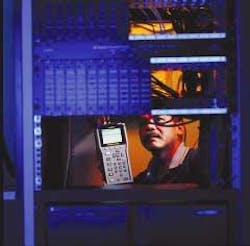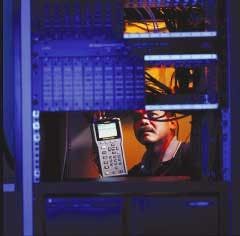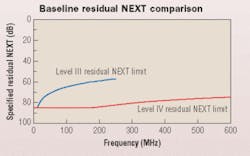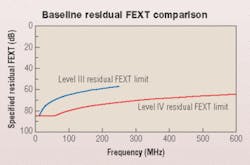Copper cable testing reaches new accuracy Level (IV)
Emerging applications are less tolerant of all noise sources, including those internal to the tester.
As the cabling industry moves toward multiple-gigabit networking applications, field testers need to support high-frequency sweeps to meet such test standards as ISO-F 600-MHz or the emerging Category 6a to 625 MHz. At these higher frequencies, the test signals are closer to the limits of the cable standard, thereby making the measurements less tolerant of the noise generated by the tester itself.
Baseline accuracy limits for field testers are specified to ensure that the intrinsic radio-frequency (RF) noise that's generated will not negatively affect the measurement of the cabling system. Currently, all field testers performing Category 5e/6 and ISO-D/E measurements must meet Level III accuracy.
Standards bodies, however, recently finalized a draft standard to improve the tester accuracy from Level III to Level IV as part of the Category 6a/7 and ISO Class F definitions. These required changes will have a significant impact on all field testers in the marketplace.
Level IV accuracy will have the following benefits:
- Cable certifiers that meet the proposed Level IV accuracy limits will be more precise with the internal noise of the tester, thus minimizing the impact on actual measurements.
- With a Level IV accuracy meter, installers can be certain that measurements will be extremely accurate at high sweep frequencies, meaning they will see the best margin possible.
- Cable warranty managers will be more likely to extend warranties to systems that are certified by equipment that provides the most accurate measurements possible.
Level IV requirements
The two components to Level IV verification are baseline measurement accuracy and permanent link and channel measurement accuracy.
The baseline measurement accuracy for any field tester is its fundamental, intrinsic measurement accuracy with no additional measurement test fixtures attached to it. Moving the certification frequencies from 250 MHz for Level III up to 600 MHz for Level IV required significant changes to the field-tester baseline measurement accuracy—specified random noise floor, residual near-end crosstalk (NEXT), and residual far-end crosstalk (FEXT). These three parameters have the greatest impact on the field tester's measurement accuracy, as the operating frequency range moved up to cover 1 to 600 MHz, to accommodate the Level IV ISO Class F measurements.
The random noise floor has been significantly lowered in the Level IV measurement-accuracy requirements when compared to those of Level III. This reduction is required to prevent the field tester's internally generated random noise from corrupting the performed LAN link measurements—up to 600 MHz for ISO Class F links.
The residual NEXT limit has also been significantly lowered from Level III accuracy. Such strict limits are required to prevent any of the tester's internal crosstalk from prohibiting the accurate measurement of the significantly reduced LAN link NEXT values specified by Class F requirements.
Similarly, the residual FEXT limit has been significantly lowered to prevent any internal FEXT within the tester from prohibiting accurate measurement of the significantly reduced LAN link FEXT values specified by Class F requirements.
Permanent links and channels
While the baseline accuracy is an indication of how well the tester hardware performs in a stand-alone configuration, it does little to qualify how accurately the tester performs when measuring actual links. The raw data includes losses and reflections introduced by the interaction of the link with the tester and its adapters.
With more-expensive laboratory instruments, such as a network analyzer, these non-link losses can be calibrated out of the measurement by setting the "reference plane" at the boundaries of the permanent link or channel. Measurements can be accurately taken by using a network analyzer that is calibrated to NIST (National Institute of Standards and Testing) standards. Then, using the network analyzer as a transfer standard, the test instrument's data can be compared to it and compared to the draft standard limits for accuracy. If the test instrument is accurate, its readings can only deviate from the network analyzer within the bounds specified by the standard.
Testers achieving Level IV accuracy can have that accuracy verified by independent, third-party testing labs. To verify accuracy, the independent third party selects test sets from production stock, and witnesses that the units pass the test limits specified within the document to Level IV requirements.
With demonstrated compliance to Level IV requirements, a tester manufacturer assures continued quality tracking of Level IV measurement accuracy for the field testers it sells.
Gerald Renken and Ed Pivonka are with Ideal Industries (www.idealindustries.com).




